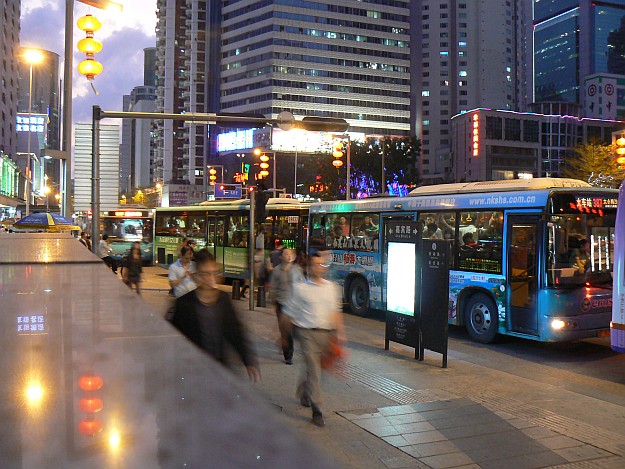
 Adam Hocherman, 34, is an entrepreneur and founder of the consumer electronics company American Innovative in Boston, MA. Adam founded the company in 2003 with the help of the US Government’s SBA loan program and is currently the 100% owner. He holds a BS in Mechanical Engineering and an MBA, both from Cornell University. Adam’s writings can be found on his blog at DesignTheatre.net and through his Twitter feed. He welcomes your comments. Read more about sourcing in China here.
Adam Hocherman, 34, is an entrepreneur and founder of the consumer electronics company American Innovative in Boston, MA. Adam founded the company in 2003 with the help of the US Government’s SBA loan program and is currently the 100% owner. He holds a BS in Mechanical Engineering and an MBA, both from Cornell University. Adam’s writings can be found on his blog at DesignTheatre.net and through his Twitter feed. He welcomes your comments. Read more about sourcing in China here.
It’s Saturday morning at 6am. I’m about to leave my Boston apartment for the first of three legs from Logan International Airport to Hong Kong via New York and Tokyo. I will arrive at 10:30pm on Sunday. Against insurmountable odds it appears that both my Boston and New York flights are on-time – an anomaly if there ever was one given that we’ve had a full week of driving rain in Boston and two feet of snow in Westchester County, just 45 minutes north of New York City where my parents told me they’ve had to sleep at a friend’s place because they’ve been without power for days. Still, never to disappoint, and despite clear sunny skies, my commuter flight from Boston to New York is delayed almost two hours on account of “missing personnel.” This conjures up images of airline top brass scrambling around to replace the guy who’s responsible for loading the salty snacks on the plane (as if) when the gate agent clarifies that our secondary officer is on his way from another city. Or maybe he overslept. Fortunately, having learned my lesson just months ago when traveling to a trade event in Las Vegas (my luggage was lost, never to be recovered to this day!) I seemingly accurately surmised that the chances of my checked baggage successfully navigating three airplanes and two carriers would be slim-to-none. As such, I had packed light. My fiancee made me pack two pair of pants, which I felt to be overkill, but I have a feeling I’ll thank her later.
So if you think you can’t fit a week’s worth of clothing into 75% of a roller carrier-on, then you’d be wrong. The other 25% of my bag is filled with a menagerie of loose electronic components, busted circuit boards from my company’s products that I want to return to the factory for analysis and a dozen rare, Russian-made numeric display components called Nixie tubes which are to be part of a forthcoming American Innovative product. As I remove my shoes for the usual TSA security dance I muse about the fact that I still have to unpack my laptop but the Kindle, iPod, BlackBerry and myriad of electronic components I’ve just described do not need to be unpacked. However, TSA has the last laugh when they flag the Nixie tubes as suspicious looking and pull me and my bag aside for further investigation. I am secretly pleased that TSA seems to be doing their job and then momentarily scared as the agent swabs down my box of gadgetry for a scan. The Nixie tubes I have on me are what are known as NOS (New Old Stock). In this case, this means that these tubes were made in communist Russia some fifty years ago although they were never installed. Who knows what else they were making. Still, I breathe a sigh of relief as I pass the scan and am freed to go.
Such is the life of a gadget manufacturer and if you think all of these Kindles, Blackberries, iPods, and even Nixie tubes are made by robots in some far off factory, you’re wrong. I learned, first-hand, how difficult – and how rewarding – the art of Chinese manufacturing has become.
Where I’m going in China, I don’t go as a tourist. The industrial zone is not a pretty place. You can’t rent a car, even if you wanted to. There is no public transportation. Pick-ups and drop-offs are pre-arranged with factories. The good news is that the factories love when I visit or, for that matter, when any Westerner visits. There’s a certain hospitality that can be found doing business in China that doesn’t exist to such a great extent in the United States. They book the hotels for me, all meals are provided. They roll out the proverbial red carpet when I visit, which is nice.
The best way to source a factory in China is to go there. For every would-be product entrepreneur whose wind I just took from your sails … relax. In fact, that is not the way that I sourced the first three factories that I ever worked with and I still work with each of those facilities to this day. I am looking forward to seeing factory owners, project managers and engineers, some of whom I’ve worked with for almost seven years.
Before I tell you how I sourced those first three factories, I want to speak to the cover article of last month’s issue (Feb, 2010) of WIRED magazine about the “New Industrial Revolution”. Like many people probably reading this article, WIRED is my favorite magazine. I read it cover to cover every month and have been doing so since almost the inception of that fond rag. In that article, “Atoms Are the New Bits”, the folks at WIRED make it out like all that’s needed these days to make and sell a product is to dial up AliBaba.com, find a factory in Asia, throw a napkin sketch at them and wait for your container of packaged corporate job freedom to arrive in America. If this were true, I would not be so willing to write this article and to give you a little peak into the secret sauce that makes my company, and other companies like mine, possible today.
Ok, so the AliBaba.com part is true. Personally, I prefer a competitive directory called GlobalSources.com but it’s about the same thing. Thousands of manufacturers have listings and photos of OEM items that they specialize in. So your first step is to perform a search for similar items – or rather, items that may be made similarly. American Innovative’s first product was an invention of my design called the Neverlate 7-day Alarm clock. In short, it is a clock radio that was designed with college students in mind – and facilitates a separate alarm setting for each day of the week in order to accommodate class schedules.
Not surprisingly, I searched for manufacturers that made clock radios and not electric motors or stuffed bears. Seems obvious, right? Well in the case of the Neverlate it was but we’re about to release a new item that is a handheld USB device with a dot-matrix screen, which we call the PBA (Personal Baby Assistant). It’s designed to help parents of infants collect data about their newborns – sleep and eating patterns, medication administration, etc. Well who makes one of those in Asia? Hopefully no one. (Aside: If you happen to find your invention during your search for a manufacturer you may want to reassess how unique your idea is. Hopefully you’ve vetted your concept long before when you performed a detailed prior art search, but that’s a whole other article for another day). If your concept is truly new then your process is the same, but you need to be a little more creative. Recall the witch scene in the 1975 movie Monty Python and The Holy Grail. What else (besides a duck) floats? Very small rocks. What else is small and electronic, has a screen and a USB port and some buttons? An MP3 player. A fancy bike computer. A heart-rate monitor. Countless things. A factory that has some experience with these items may be a good candidate to investigate further. Find a dozen such companies and make a list. You’ve completed step one – the long list.
The next step is a little harder. You need to turn the long list into a short list and here’s how you do that. Get out your spec. You do have a spec, right? Ok, get out the napkin sketch. Now open a Word document and write down exactly how your product operates from a user perspective. What do the screens look like? How does the unit respond when buttons are pressed? What are the expectations for brightness, battery life, audio quality if you’re doing a hi-fi or talking device, textile quality and texture if you’re doing a cut-and-sew, materials safety, and so forth.
Sound difficult? It is if you’re not serious about your product. If you’ve been lying awake nights dreaming about making this widget, then you’ve already done the hard part – now put it down on paper. How about the external design? Regrettably it is outside the scope of this article to get into too much minutia on this subject but suffice to say that good visuals will both result in a final product that is closer to the vision in your mind and will lead potential manufacturing partners to take you more seriously. After all, it may be China but a napkin sketch there is perceived the same way a manufacturer would perceive a napkin sketch here. Do yourself a favor. Go to Coroflot.com and spend a few hundred dollars to have a bright freelancer or a RISD student work you up some drawings or, better yet, a basic 3D model. Whoa. You want me to spend money? Regrettably yes. And if you’re not willing to spend three hundred dollars for drawings then you should not be proceeding down the “go it alone” path. The trick is to spend smart money. Some good eye candy is excellent bang for the buck, particularly if it’s a 3D Alias model (which can directly feed the mechanical design stage someday).
Ok, spec in hand, it’s time to turn that long list into a short list. Stay tuned for the second installment, coming tomorrow.

